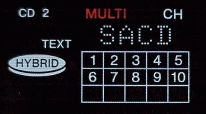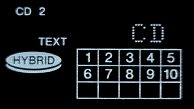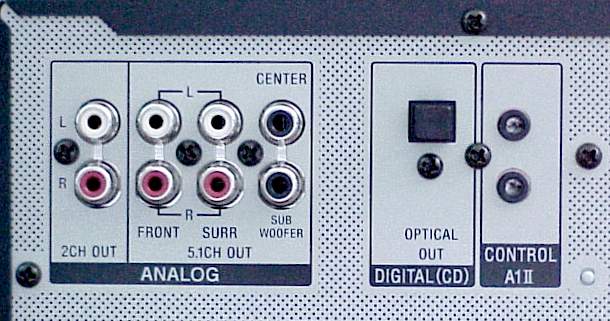Product Review - Sony SCD-CE775
CD/SACD Player - April, 2002
John E. Johnson, Jr.
![]()
|
|
Specifications: Formats: CD and Multi-Channel (5.1) SACD; 5-Disc Carousel Tray MFR: 2 Hz - 50 kHz ± 3 dB THD: 0.0020% Dimensions: 4 1/4" H x 17" W x 15 3/4" D MSRP: $199
USA |
|
Sony Electronics; http://www.sony.com |
Introduction
Now that DVD is "nothing new", it is time to talk about the next stage in
consumer electronics, which is higher resolution music. The CD offered 16 bit
- 44.1 kHz sampling, and we thought that was pretty amazing. With DVD, the
video portion of the signal takes up so much room, only compressed audio would
fit along with it, especially when you take into account 5.1 channels. Both
Dolby Digital (DD) and DTS are compressed. They are 20 bit - 48 kHz, but most
of the bits have been eliminated. No matter how you look at it, this does
attenuate the sound quality. Not an awful lot, but some. Purists want better.
Enter SACD and DVD-A. These two formats are for audio only discs. No video. At
least not movies . . . yet. HD-DVDs are in the works, which will hold high
definition movies, and probably along with SACD and DVD-A quality sound
tracks. But, for now, only the high resolution sound will fit on a DVD
substrate (SACD is not considered DVD even though it is placed on that type of
storage media).
SACD stands for "Super Audio Compact Disc". We will cover the details of how this works in a later article, but in brief, whereas conventional CDs have words that are 16 bits in length, DSD uses 1 bit words. The CD (and DVD-A) has Pulse Code Modulation (PCM), while SACD, with its 1 bit words, is called, by Sony and Philips, Direct Stream Digital, or DSD. The actual number of bits flowing through the system is about the same for SACD and DVD-A, but of course, both camps feel their technology gives the best sound. Just like we have had with DD and DTS, there will be polarization on the news groups and magazines as to which one sounds best, but for now, let's just evaluate how good the review product sounds in its own right.
The Sony
The first SACD players were in the multi-thousands of dollars, and they were only two-channel. Of course, we all knew that eventually they would emerge in the mass market, and here they are. The CE775 is a carousel multi-channel (5.1) SACD player for only $200, and the street price is $179. We are talking CostCo material here.
Carousel CD players have been around for years, and they have all figured out how to arrange the buttons long ago. The 775 is no different, except for what you see on the LED panel display. You have the On/Off button, Disc 1-5 Select buttons, Shuffle, Program, Repeat, Time Remaining, etc., just like previous CD players. Open/Close, Headphones Level Control . . . <yawn> . . . so what's new here?
The 775 has a couple of things you won't see on a CD player, namely the SACD/CD button and Multi-Channel Decoding indicator. When you put an SACD into the player, it first reads the TOC (Table of Contents), then displays the contents as shown below:

It tells you that the disc is a multi-channel SACD, as opposed to two-channel, and that the disc is a hybrid, meaning that it has a CD layer on it so that it will play on a conventional CD player. That way, you can collect the SACD discs as they come out, and you can play them on your old CD player until you buy an SACD player. The display also says "Text" which indicates that the title of the disc will be displayed (disc title, artist, and track title can be selected for display).
A small SACD/CD button lets you switch between the SACD and CD layers if you like, so you can hear the difference. The player has to be stopped before you can switch layers, but even so, there is quite an audible difference in sound, at least to my ears. However, the comparison is not absolute, since the music was recorded in DSD and then down-converted to PCM for the CD layer, as opposed to a true comparison which would involve recording the music with two recorders, one DSD and one PCM. Here is what the panel looks like after the switch.

The rear panel of the player is pretty banal (shown below).

A close-up (shown below) illustrates the handful of jacks. On the other hand, maybe this is a blessing. It makes the connections pretty difficult to screw up.

From left to right, there is one set of two-channel analog out, for listening to CDs, two-channel SACDs, and also for listening to multi-channel SACDs when you only have a two-channel audio system. There is one more button on the front for doing that. You could also just use the front Left and Right output jacks in the 5.1 section of the panel, but if you have a receiver with 5.1 analog input jacks, you would also need to use the 2Ch Out set of jacks to a regular input pair on the receiver so you would be able to have Pro Logic or DPL-II processing with a stereo disc.
A Toslink optical jack carries digital signals to your receiver/processor, but it is only for CD. There is no digital output when you are in SACD mode (no down-conversion). So what happens when you are using the digital connection to your receiver and you have a mixture of CDs and SACDs in the carousel? You would have to switch to the 5.1 analog connections setting. Inconvenient? It certainly is. Does it have to be this way? No, but the music producers won't let us have a digital SACD connection until the copyright protection schemes are in place. Lastly, there are a pair of Control A1 II jacks for connections to other Sony components.
The 775 comes with the ubiquitous remote control, shown below.

It looks and works like any other remote, except for those new SACD/CD and Multi/2Ch buttons. The AMS buttons at the bottom for for Automatic Music Search, and will take you forward or backward one track at a time, as well as let you have access to some other menu functions, such as the language you want the text displayed in. That same control on the player front panel is a rotary dial.
Click HERE to go to
Part 2 - The Sound
![]()
© Copyright 2002 Secrets of Home Theater & High Fidelity
Return to Table of Contents for this Issue.


